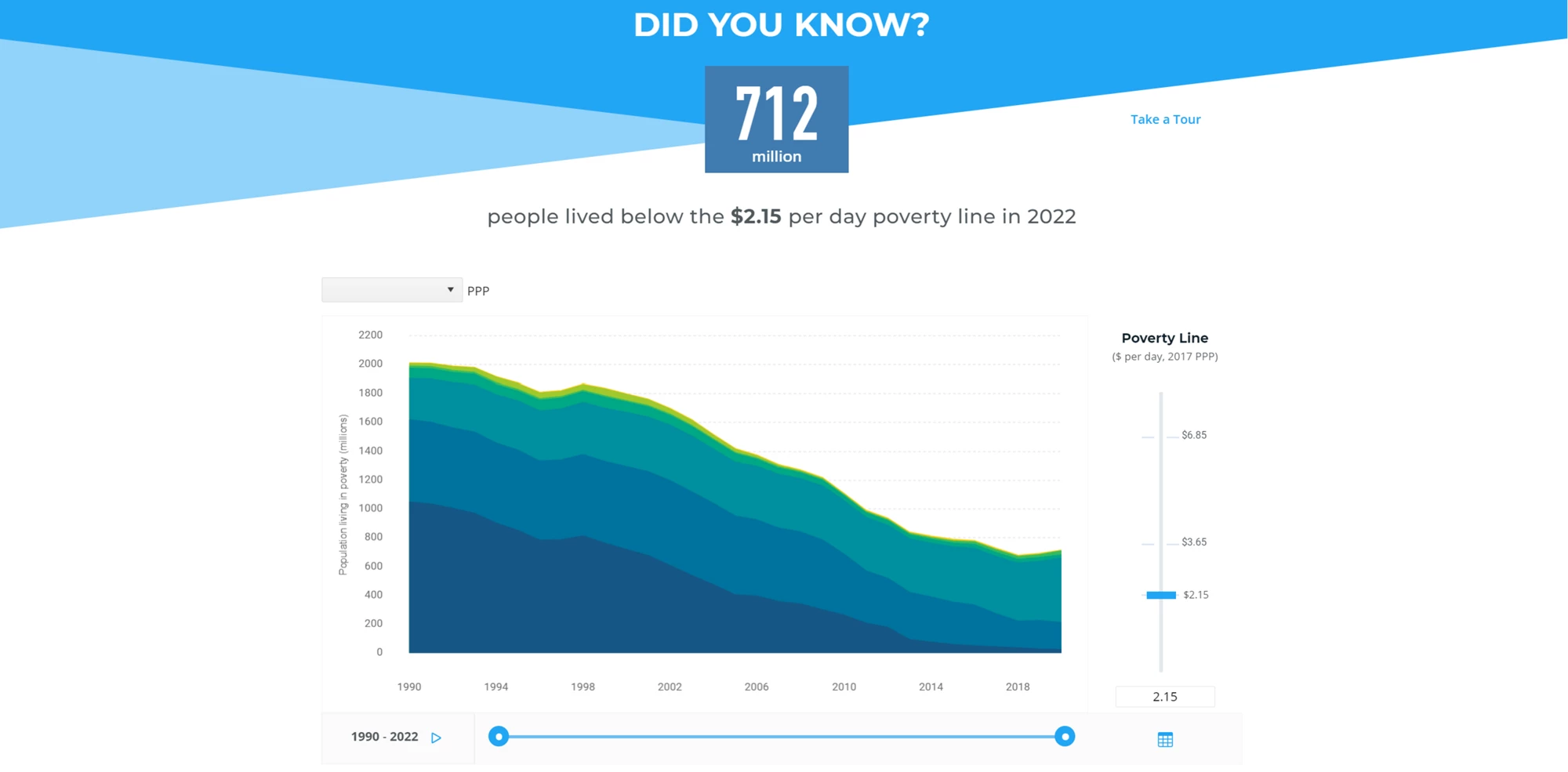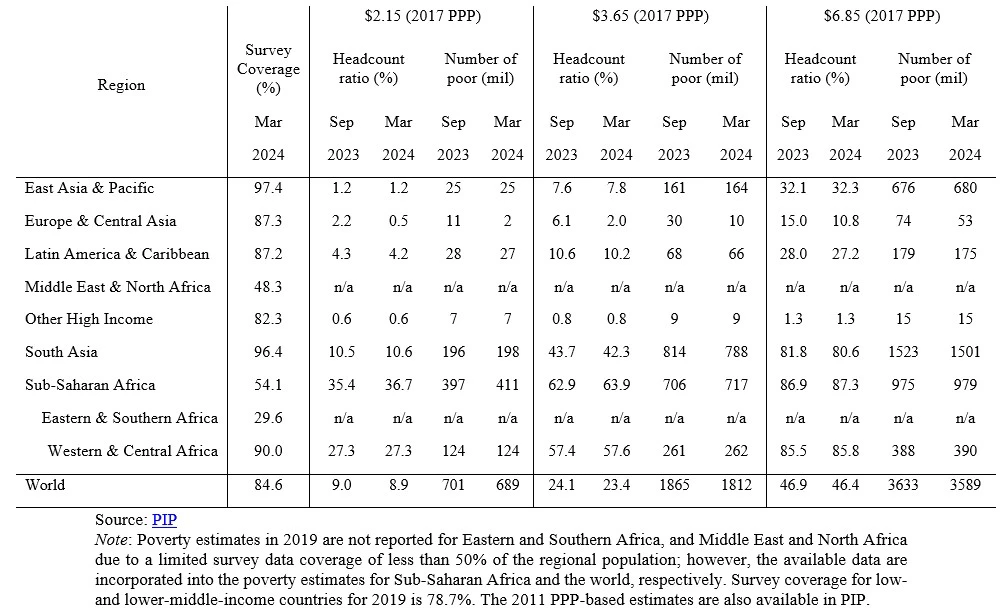
Global poverty estimates were updated today on the Poverty and Inequality Platform (PIP). As explained in more detail in the What’s New document, more than 100 new surveys were added to the PIP database, bringing the total number of surveys to more than 2,300. With more recent survey data, this March 2024 PIP update is the first to report a global poverty number for 2020-2022, the period of the COVID-19 pandemic. We estimate that COVID-19 increased extreme poverty in the world, as measured by the international poverty line of $2.15, from 8.9 percent in 2019 to 9.7 percent in 2020 (see Figure 1). This is the first increase in global poverty in decades. It is in line with earlier estimates of the COVID-19 impact which used limited survey data and GDP growth projections.
The global increase in extreme poverty in 2020 is driven by South Asia, where extreme poverty increased by 2.4 percentage points to 13 percent between 2019 and 2020. In Latin America and the Caribbean, however, extreme poverty continued to decline in 2020, which is driven by Brazil. This can be explained by the role of fiscal policy in mitigating the economic impacts of the COVID-19 shock. At a higher poverty line of $3.65 (the poverty line more relevant for assessing poverty in lower-middle-income countries), poverty also fell in Latin America and the Caribbean and in East Asia and the Pacific even in 2020. At $6.85 (the poverty line more relevant for assessing poverty in upper-middle-income countries), poverty also declined in 2020 in Europe and Central Asia and in advanced countries (“Other High Income”). Unfortunately, survey coverage during the post-2019 period is still limited in Sub-Saharan Africa and the Middle East and North Africa, so we cannot report poverty estimates beyond 2019 for these regions.
Figure 1: Global and regional poverty estimates, 1990 - 2022
Following the widespread recession in 2020, economies around the world started to recover in 2021 and extreme poverty levels were lower than pre-pandemic levels in the more prosperous regions of the world by 2022 (East Asia and the Pacific, Latin America and the Caribbean, advanced countries, Europe and Central Asia, and South Asia). For the world, however, global poverty was still marginally above pre-pandemic levels by 2022, though on a declining trend. The new estimates of extreme poverty in the world in the period 2020-2022 are quite similar to earlier projections. An estimated 23 million more people were living in extreme poverty in 2022, compared to 2019.
That extreme poverty levels were lower in 2022 relative to 2019 for more prosperous regions, but not for the world, suggests that the economic recovery from the pandemic was uneven and slower for Sub-Saharan Africa where more than half of the extreme poor live. The year 2022 also came with another global shock – Russia’s invasion of Ukraine, which contributed to rising inflation in low-, middle- and high-income countries. At the $3.65 and $6.85 poverty lines, the global poverty rate in 2022 are lower the levels recorded in 2019. This result is consistent with the recovery being faster in more prosperous regions, considering that Sub-Saharan Africa accounts for a smaller share of the global poor at these higher lines compared to the extreme poverty line.
This March 2024 global poverty update from the World Bank incorporates updated CPI, national accounts and population data, and revises previously published global and regional estimates from 1981 to 2022. The methodology used for lining up regional and global poverty has also been revised, which leads to small changes. For more details, see the What’s New document. Figure 1 shows global and regional poverty trends at all three global absolute poverty lines of the World Bank (see the poverty series using 2011 PPPs here.) Table 1 summarizes the revisions to the regional and global poverty estimates between the September 2023 data vintage and the March 2024 data vintage for the 2019 reference year at all three poverty lines.
Table 1: Poverty estimates for reference year 2019, changes between the September 2023 and March 2024 PIP vintages

Given all the new data points and revisions to PIP data and methodology in this update, global extreme poverty in 2019 has been revised down marginally by 0.1 percentage points to 8.9 percent, resulting in a downward revision in the number of poor people from 701 to 689 million. The global reduction in the millions of extreme poor occurs despite an upward revision in Sub-Saharan Africa (14 million). The reduction is driven by Europe and Central Asia and the Middle East and North Africa, where new survey data have recently become available to replace extrapolations of very old surveys (the regional estimate for Middle East and North Africa cannot be shown since it does not meet the 50% population cut-off.) For example, new survey data for 2022 have been added for Syria and Uzbekistan, for which the latest surveys were 2003 in the previous vintage of the data. At $3.65 and $6.85, poverty rates have been revised down by 0.7 and 0.6 percentage points, representing a reduction in global poverty counts by 52 and 44 million, respectively. These downward revisions in global poverty estimates at these higher poverty thresholds are driven by Europe and Central Asia and South Asia.
For more details on the March 2024 PIP update from the World Bank, see the What’s New document.
Would you like to be updated with the latest news on PIP? Register to our newsletter here.
The authors gratefully acknowledge financial support from the UK Government through the Data and Evidence for Tackling Extreme Poverty (DEEP) Research Program.








Join the Conversation